Fun Trail Facts
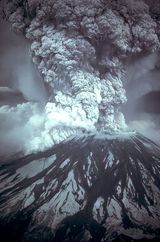
Right after the eruption of Mount St. Helens, local newspapers reported that Spirit Lake (pictured above) had all but disappeared, as it appeared indistinguishable from the Dante-esque landscape in the Blast Zone on the south facing slopes of the mountain. In reality, it was just camouflaged underneath the felled forest and volcanic debris that was floating on its surface. While it is a gorgeous blue lake now, an ever-present reminder of the eruption over thirty years ago remains; A ghostly layer of floating trees remains on part of its surface, giving the impression of ice when first glanced upon.
No fish were found in Spirit Lake until 1993, 13 years after the eruption. Recent population counts have shown expansion in both abundance and growth rates.
No fish were found in Spirit Lake until 1993, 13 years after the eruption. Recent population counts have shown expansion in both abundance and growth rates.
Trail Info
| Hike/Section Name Boundary Trail #1 Norway Pass TH to Norway Pass County & State Skamania County, Washington Ecoregion Cascades | Western Cascades Montane Highlands Forest Gifford Pinchot National Forest Latitude & Longitude (DEC) 46.3101110, -122.1056504 Family Friendliness Tough hike for Dad the pack mule, but a pretty phenomenal hike for the little guy. Rarely was I nervous about the lad hiking by himself next to me. Hike Difficulty Moderate [lengthy with some decent elevation gain] Elevation 4,518 Feet Elevation Gain 873 Feet Distance 4.5 Miles Route Type Out and Back Access to Trailhead (Link) A breeze. After taking Forest Road 26 from NF-99, you come right up on the parking for the trailhead. |
Trip Report
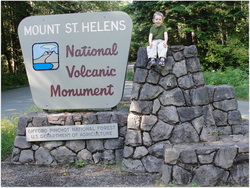
Taking the Boundary Trail from the Norway Pass Trailhead up to Norway Pass was an amazing journey for us. The drive alone was awe-inspiring, watching the landscape change from beautiful Cascade forest into a rugged and desolate terrain, where the skeletons of scorched trees still point upward at the sky.
The trip up to Norway Pass is situated right in the middle of this zone, but the thirty-plus years since the eruption have softened the absolute destruction. Nearby Meta Lake and the wildflowers everywhere provide a welcome contrast to the pumice-laden and barren stretches that hint at what was the rule of the area rather than the exception.
The trip up to Norway Pass is situated right in the middle of this zone, but the thirty-plus years since the eruption have softened the absolute destruction. Nearby Meta Lake and the wildflowers everywhere provide a welcome contrast to the pumice-laden and barren stretches that hint at what was the rule of the area rather than the exception.
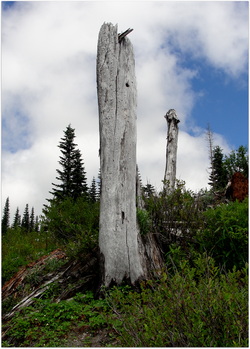
Speaking of barren, this hike was a dry and dusty journey. Really, really, really dusty.
I should know better than to think such things, but every time we got ash and dust on us, I kept thinking about how we were inhaling fragments of pulverized rock, minerals, and volcanic glass.
Being late July, it was a sweltering journey at times as well. Until we hit the snow. More on that later.
For those reasons, I highly recommend that you start this trek early in the day and definitely take more water than you think you'll need. I'm usually in the position of constantly offering my son water to make sure he stays hydrated during such trips, but this was one journey that he needed no extra prodding.
FYI - There is a fantastic water pump at the trail head.
I should know better than to think such things, but every time we got ash and dust on us, I kept thinking about how we were inhaling fragments of pulverized rock, minerals, and volcanic glass.
Being late July, it was a sweltering journey at times as well. Until we hit the snow. More on that later.
For those reasons, I highly recommend that you start this trek early in the day and definitely take more water than you think you'll need. I'm usually in the position of constantly offering my son water to make sure he stays hydrated during such trips, but this was one journey that he needed no extra prodding.
FYI - There is a fantastic water pump at the trail head.
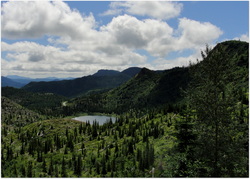
Once you get some elevation (which happens quickly during the first mile), Meta Lake becomes very visible from your dusty perch. Amazingly, this 9-acre lake that was in the blow down zone maintained its circle of life after the eruption, as self-reproducing Eastern Brook trout survived the blast and thrived afterward without much competition. I have to imagine the snow helped. Now you can see lushness all around, as reeds and grass share the nearby shore with hemlock and Douglas firs.
While standing there thinking about how nice a dip would be in such water, I realized that it was getting warmer and that we still had a long way to go. With that in mind, the two of us continued cruising up in elevation, watching the subtle changes in scenery, and getting the opportunities to really learn from one of the greatest geological and ecological laboratories in the region. Primary, secondary, and tertiary succession were really easy concepts to teach the lad on this hike, as examples were everywhere.
While standing there thinking about how nice a dip would be in such water, I realized that it was getting warmer and that we still had a long way to go. With that in mind, the two of us continued cruising up in elevation, watching the subtle changes in scenery, and getting the opportunities to really learn from one of the greatest geological and ecological laboratories in the region. Primary, secondary, and tertiary succession were really easy concepts to teach the lad on this hike, as examples were everywhere.
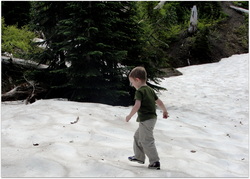
Being late July, it had been months since we had thought of snow. Much to my happiness, and definitely to that of the lad's, we came across a beautiful patch of the white stuff that was slowly melting. After testing the depth, I let the boy go to town.
While he played, I soaked my hat in some melted snow and was never so happy to have such chilliness flow down the back of my neck. It was a really welcome break, and his giddiness was contagious. Needless to say, snowball fights ensued.
While he played, I soaked my hat in some melted snow and was never so happy to have such chilliness flow down the back of my neck. It was a really welcome break, and his giddiness was contagious. Needless to say, snowball fights ensued.

Once we left our little winter wonderland, we climbed up the elevation a bit more and were treated to some amazing flowers. Penstemon, bear grass, lupine, paintbrush, and foxglove all called out to us. Douglas fir and mountain hemlock are starting to grow quite nicely, mixed together with blasted tree trunks. Hummingbirds and bees were feasting.
It was just awe-inspiring, knowing that before the recovery, the soil had practically been blasted down to the bedrock. Thanks to some fierce competition between some ornery species, the beauty of the forest is returning.
It was just awe-inspiring, knowing that before the recovery, the soil had practically been blasted down to the bedrock. Thanks to some fierce competition between some ornery species, the beauty of the forest is returning.

Upon reaching Norway Pass, we took it upon ourselves to feast and explore a rough path that went just a little bit down toward Spirit Lake. The Independence Trail was closed, and we sure weren't making the trek to Mt. Margaret (that day...), so we got to just sit back and watch the cloud-covered giant of a volcano in the distance.
After pulling out the binoculars, we managed to catch some great views of the high-water mark around the lake that was left by the devastation from the summit of Mt. Saint Helens sliding into Spirit Lake three decades back. Apparently, the water was pushed up 800 feet during the event.
After some goofing around and quiet reflection on everything that we had seen thus far, we turned around and headed down. We got to play some more in the snow and really get some new vantage points of things we had missed on the way up - Mt. Rainier, a gorgeous nearby waterfall, and way too many chipmunks.
My favorite part on the way down was winning a bet with the boy around the fact that I could make a rock float. When he saw pumice do its thing, he was as giddy as I remember being the first time I ever saw it bobbing on top of water. I should have bet him $5, but instead it was just a friendly bet without a wager.
After pulling out the binoculars, we managed to catch some great views of the high-water mark around the lake that was left by the devastation from the summit of Mt. Saint Helens sliding into Spirit Lake three decades back. Apparently, the water was pushed up 800 feet during the event.
After some goofing around and quiet reflection on everything that we had seen thus far, we turned around and headed down. We got to play some more in the snow and really get some new vantage points of things we had missed on the way up - Mt. Rainier, a gorgeous nearby waterfall, and way too many chipmunks.
My favorite part on the way down was winning a bet with the boy around the fact that I could make a rock float. When he saw pumice do its thing, he was as giddy as I remember being the first time I ever saw it bobbing on top of water. I should have bet him $5, but instead it was just a friendly bet without a wager.
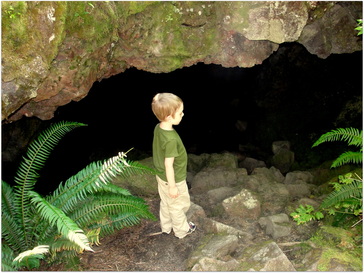
While driving toward the southern end of the volcano, we had to stop by the Trail of Two Forests Interpretive Site. We didn't have enough time to make our way through the Ape Caves, but this really worked out. Not only do you truly get to see two different forests split in the middle, but there are amazing tree molds that remain in the lava beds. There are very kid-friendly tree casts, and the boardwalk through the trail provides a really casual experience.
Of course, we had to take the trail away from the boardwalk and go find some bigger caves that did not have any bats hanging out. We found plenty along the slight trails, just about half of a mile away from the Interpretive Site itself.
On the way home, I found myself promising the boy that we would be back. Next time, it'll just be further up to Mt. Margaret and all the way into the Ape Caves.
Of course, we had to take the trail away from the boardwalk and go find some bigger caves that did not have any bats hanging out. We found plenty along the slight trails, just about half of a mile away from the Interpretive Site itself.
On the way home, I found myself promising the boy that we would be back. Next time, it'll just be further up to Mt. Margaret and all the way into the Ape Caves.
More Information
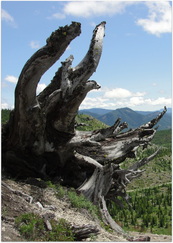


 RSS Feed
RSS Feed
